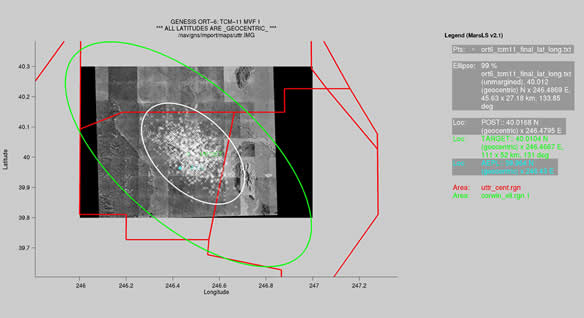At 9:55 a.m. MDT,
the capsule entered Earth's atmosphere at a velocity
of approximately 11.04 kilometers per second (24,706
miles per hour). The only human-made object to re-enter
Earth's atmosphere at a higher speed was the Apollo
10 command module, which hit 11.11 kilometers per second
(24,861 mph). When it entered the atmosphere, the Genesis
capsule was over northern Oregon. The capsule stabilized
with its nose down because of the location of its center
of gravity, its spin rate and its aerodynamic shape.
In an optimal situation, forty-five
seconds after entry, the capsule will be exposed to
a deceleration force three times the force of Earth
gravity, or 3 G's. This arms a timer that is started
when the deceleration force passes back down through
3 G's. All of the parachute releases are initiated from
this timer. Sixty seconds after entry, at an altitude
of 60 kilometers (197,000 feet), the exterior temperature
of the heat shield will peak at about 2,500 C (4,500
F). Slightly over 10 seconds later, the capsule will
be exposed to about 30 G's, the greatest deceleration
it will endure during Earth entry. During this time
period, the capsule's heat shield will lose an estimated
3 kilograms (about 7 pounds), or about 6 percent of
its weight, as a small amount of the ablative material
erodes away with the heat generated during entry through
the atmosphere.
At 127 seconds into entry at an
altitude of about 33 kilometers (108,000 feet), a mortar
aboard the capsule will fire, releasing the 2.03-meter-diameter
(6.7-foot) drogue parachute to provide stability to
the capsule until the main chute is released. The capsule's
heat shield will rapidly cool during this subsonic portion
of the descent.
Four minutes and fifteen seconds
later, at an altitude of 6,700 meters (22,000 feet),
three pyrotechnic bolts will release the drogue chute
from the capsule. As the drogue chute moves away, it
will extract the capsule's main chute, a 10.5- by 3.1-meter
(34.6- by 12.1-foot) parafoil. Full inflation of the
parafoil will occur in about 6 seconds. Once inflation
is complete, the parafoil and its payload will begin
a slow, loose spiral descent through the skies of the
Utah Test & Training Range.
 |
Genesis landing pre-return footprint and projected landing targets
|
Mishap
Investigation Board Report
The landing footprint for the sample
return capsule is an ellipse that takes in most of the
Utah Test & Training Range, except for some areas
that have a high population density. The footprint is
an ample area to allow for aerodynamic uncertainties
and winds that might affect the direction the capsule
travels during its descent.
|
